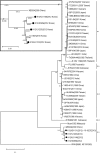Detection of Japanese encephalitis virus genotype V in Culex orientalis and Culex pipiens (Diptera: Culicidae) in Korea
- PMID: 25658839
- PMCID: PMC4319795
- DOI: 10.1371/journal.pone.0116547
Detection of Japanese encephalitis virus genotype V in Culex orientalis and Culex pipiens (Diptera: Culicidae) in Korea
Abstract
Japanese encephalitis virus (JEV) causes significant viral encephalitis and is distributed throughout the Asian countries. The virus is known to be transmitted by Culex tritaeniorhynchus, which mainly breeds in rice paddies in Korea. In this study, we investigated the presence of other mosquito species that can transmit JEV as a second or regional vector. We selected five cities where patients have experienced JE in the last 5 years as mosquito-collecting locations and subdivided them into four collection sites according to the mosquito habitats (cowshed, downtown area, forest, and swamp). Mosquitoes were caught using the BG-Sentinel trap, CDC black-light trap, Fay-Prince trap, and Gravid trap. A total of 993 pools from 22,774 mosquitoes were prepared according to their species, collection date, and site. We performed a SYBR Green 1-based real-time RT-PCR assay to detect JEV from the mosquito pools. A total of six JEV-positive pools were detected from Culex orientalis and Culex pipiens caught in the Gangwon-do and Gyeonngi-do provinces. All the detected JEVs were revealed as genotype V by phylogenetic analysis of the envelope gene. Our findings confirm that a new genotype of JEV was introduced in Korea and suggest that two mosquito species may play a role in JEV transmission.
Conflict of interest statement
Figures


Similar articles
-
Emergence of Japanese encephalitis virus genotype V in the Republic of Korea.Virol J. 2011 Sep 23;8:449. doi: 10.1186/1743-422X-8-449. Virol J. 2011. PMID: 21943222 Free PMC article.
-
Molecular detection and genotyping of Japanese encephalitis virus in mosquitoes during a 2010 outbreak in the Republic of Korea.PLoS One. 2013;8(2):e55165. doi: 10.1371/journal.pone.0055165. Epub 2013 Feb 4. PLoS One. 2013. PMID: 23390520 Free PMC article.
-
New strains of Japanese encephalitis virus circulating in Shanghai, China after a ten-year hiatus in local mosquito surveillance.Parasit Vectors. 2019 Jan 9;12(1):22. doi: 10.1186/s13071-018-3267-9. Parasit Vectors. 2019. PMID: 30626442 Free PMC article.
-
Ecology and geographical expansion of Japanese encephalitis virus.Annu Rev Entomol. 2009;54:17-35. doi: 10.1146/annurev.ento.54.110807.090510. Annu Rev Entomol. 2009. PMID: 19067628 Review.
-
Review of climate, landscape, and viral genetics as drivers of the Japanese encephalitis virus ecology.PLoS Negl Trop Dis. 2013 Sep 12;7(9):e2208. doi: 10.1371/journal.pntd.0002208. eCollection 2013. PLoS Negl Trop Dis. 2013. PMID: 24069463 Free PMC article. Review.
Cited by
-
Growth, Pathogenesis, and Serological Characteristics of the Japanese Encephalitis Virus Genotype IV Recent Strain 19CxBa-83-Cv.Viruses. 2023 Jan 14;15(1):239. doi: 10.3390/v15010239. Viruses. 2023. PMID: 36680278 Free PMC article.
-
Japanese Encephalitis Virus Interaction with Mosquitoes: A Review of Vector Competence, Vector Capacity and Mosquito Immunity.Pathogens. 2022 Mar 3;11(3):317. doi: 10.3390/pathogens11030317. Pathogens. 2022. PMID: 35335641 Free PMC article. Review.
-
Characterization of genotype V Japanese encephalitis virus isolates from Republic of Korea.Emerg Microbes Infect. 2024 Dec;13(1):2362392. doi: 10.1080/22221751.2024.2362392. Epub 2024 Jun 10. Emerg Microbes Infect. 2024. PMID: 38808613 Free PMC article.
-
Japanese Encephalitis Virus Surveillance in U.S. Army Installations in the Republic of Korea from 2021 to 2023.Pathogens. 2024 Aug 20;13(8):705. doi: 10.3390/pathogens13080705. Pathogens. 2024. PMID: 39204305 Free PMC article.
-
Vector competence of European Aedes mosquito species for Japanese encephalitis virus under fluctuating temperature conditions.Curr Res Parasitol Vector Borne Dis. 2025 Jul 31;8:100302. doi: 10.1016/j.crpvbd.2025.100302. eCollection 2025. Curr Res Parasitol Vector Borne Dis. 2025. PMID: 40808765 Free PMC article.
References
-
- Chambers TJ, Hahn CS, Galler R, Rice CM (1990) Flavivirus genome organization, expression, and replication. Annu Rev Microbiol 44: 649–688. - PubMed
-
- Chen WJ, Dong CF, Chiou LY, Chuang WL (2000) Potential role of Armigeres subalbatus (Diptera: Culicidae) in the transmission of Japanese encephalitis virus in the absence of rice culture on Liu-chiu islet, Taiwan. J Med Entomol 37: 108–113. - PubMed
Publication types
MeSH terms
Substances
Associated data
- Actions
- Actions
- Actions
- Actions
- Actions
- Actions
LinkOut - more resources
Full Text Sources
Other Literature Sources

